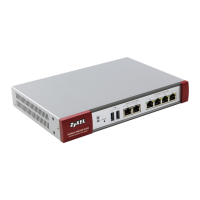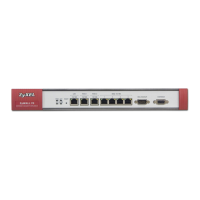Chapter 9 Interfaces
USG20(W)-VPN Series User’s Guide
214
9.9 Virtual Interfaces
Use virtual interfaces to tell the USG where to route packets. Virtual interfaces can also be used in
VPN gateways (see Chapter 21 on page 333).
Virtual interfaces can be created on top of Ethernet interfaces, VLAN interfaces, or bridge
interfaces. Virtual VLAN interfaces recognize and use the same VLAN ID. Otherwise, there is no
difference between each type of virtual interface. Network policies (for example, security policies)
that apply to the underlying interface automatically apply to the virtual interface as well.
Like other interfaces, virtual interfaces have an IP address, subnet mask, and gateway used to
make routing decisions. However, you have to manually specify the IP address and subnet mask;
virtual interfaces cannot be DHCP clients. Like other interfaces, you can restrict bandwidth through
virtual interfaces, but you cannot change the MTU. The virtual interface uses the same MTU that the
underlying interface uses. Unlike other interfaces, virtual interfaces do not provide DHCP services,
and they do not verify that the gateway is available.
9.9.1 Virtual Interfaces Add/Edit
This screen lets you configure IP address assignment and interface parameters for virtual
interfaces. To access this screen, click the Create Virtual Interface icon in the Ethernet, VLAN, or
bridge interface summary screen.
Check Timeout Enter the number of seconds to wait for a response before the attempt is a failure.
Check Fail
Tolerance
Enter the number of consecutive failures before the USG stops routing through the
gateway.
Check Default
Gateway
Select this to use the default gateway for the connectivity check.
Check this
address
Select this to specify a domain name or IP address for the connectivity check. Enter
that domain name or IP address in the field next to it.
Check Port This field only displays when you set the Check Method to tcp. Specify the port
number to use for a TCP connectivity check.
Related Setting
Configure WAN
TRUNK
Click WAN TRUNK to go to a screen where you can configure the interface as part of a
WAN trunk for load balancing.
Configure Policy
Route
Click Policy Route to go to the screen where you can manually configure a policy
route to associate traffic with this bridge interface.
OK Click OK to save your changes back to the USG.
Cancel Click Cancel to exit this screen without saving.
Table 81 Configuration > Network > Interface > Bridge > Add / Edit (continued)
LABEL DESCRIPTION

